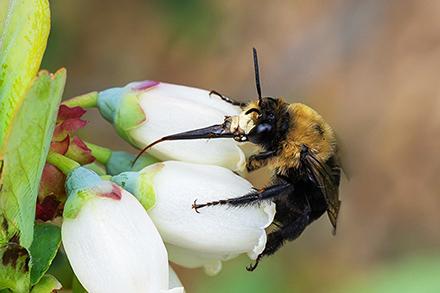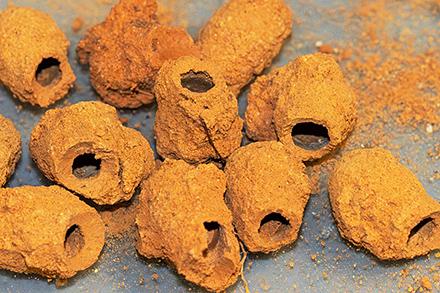Transplanted Bees Help Blueberry Fields Flourish

Male chimney bee resting on a cluster of southern highbush blueberry flowers. (Photo by Blair Sampson, ARS)
Pollinating bees are in decline, and those that remain may not be up to the task of pollinating all the crops needed to feed the nation. To help keep food on the table, researchers are looking to native wild bees to take up the slack, especially for blueberries and other fruit crops.
“Honeybees are considered a universal crop pollinator worldwide, but their populations are in trouble, and they do not always pollinate certain crop plants efficiently,” said Blair Sampson, entomologist with the Agricultural Research Service’s Southern Horticultural Research Laboratory in Poplarville, MS. “Therefore, we [are turning] to wild native bees that share a much longer ecological history with our native North American crops.”
Some of these native bees can be managed like the honeybee, which means beekeepers and farmers can relocate colonies from their home regions for deployment to where crops are blooming. Native bees are very docile when being handled and they take care of themselves with little need for human involvement. Sampson is studying such a native bee, the chimney bee (also known as the miner bee).
Chimney bees are turning out to be an important find for blueberry growers.
In addition to the problem of declining populations, honeybees have difficulty pollinating blueberries due to their relatively short tongue and preference for other plants. Another wild bee, the southeastern blueberry bee, is an abundant and efficient specialist pollinator of blueberries throughout the Gulf Coast states. Unfortunately, many growers in lower-lying areas lack these bees or have too few of them in their fields. These blueberry bees cannot be managed, but the chimney bee, a close relative, can be actively managed and moved in to fill the pollinator void.

Excavated cocoons of the chimney bees. (Photo by Blair Sampson, ARS)
While chimney bees are not yet commercially available, relocating them is fairly simple, Sampson said. Gathering chimney bee cocoons from nests in the soil that sticks to the roots of fallen trees or roadside clay outcrops requires careful excavation and skilled handlers, but nesting material can simply be sun-dried clay-rich mud gathered locally. Further, there is no need for specialized tools and costs are minimal.
Chimney bees must be shipped while in a dormant state, then gently warmed to complete their development and emerge from their cocoons. Further, water and additional nesting material should be available to help them thrive.
“These bees do not produce enough honey for us, just enough for themselves, hence, chimney bees’ principal role would be as fruit pollinators,” Sampson explained. “However, the chimney bee does show certain qualities that highlight their ideal candidacy for commercial management: they are flower generalists with a strong homing instinct, and hence will nest in the same location for many years. They also nest in dense aggregations and remain gentle around people near their nest sites.”
Sampson said that adult chimney bees resemble small, fast-flying bumble bee workers, yet they nest and behave very differently.
The bees get their name from their horizontal tubular nests that resemble tiny mine shafts in clay, which they harden into “adobe” with the help of water they collect. As they dig deeper into a clay bank, they use this excess clay to fashion a downward facing tube or “chimney” hanging off the nest entrance.
Locating and relocating chimney bee nests is fairly easy, because they’re easy to find after construction projects or natural weather events disturb the land and give bees easy access to fresh-turned clay. After finding the nests, Sampson gathers earthen cocoons and moves them to where they are tested or released as fruit pollinators.
“Since pollinator habitat is continually declining due to increasing urbanization and crop cultivation, managing wild native bees, such as chimney bees, can help conserve vital natural resources and help farmers increase their yields,” Sampson said. “And, for fruit, nuts, and vegetable crops, native bees will be an essential component for optimizing crop production per acre of land, which is vital for maintaining a stable global food supply.” – by Scott Elliott, ARS Office of Communications
You May Also Like:

